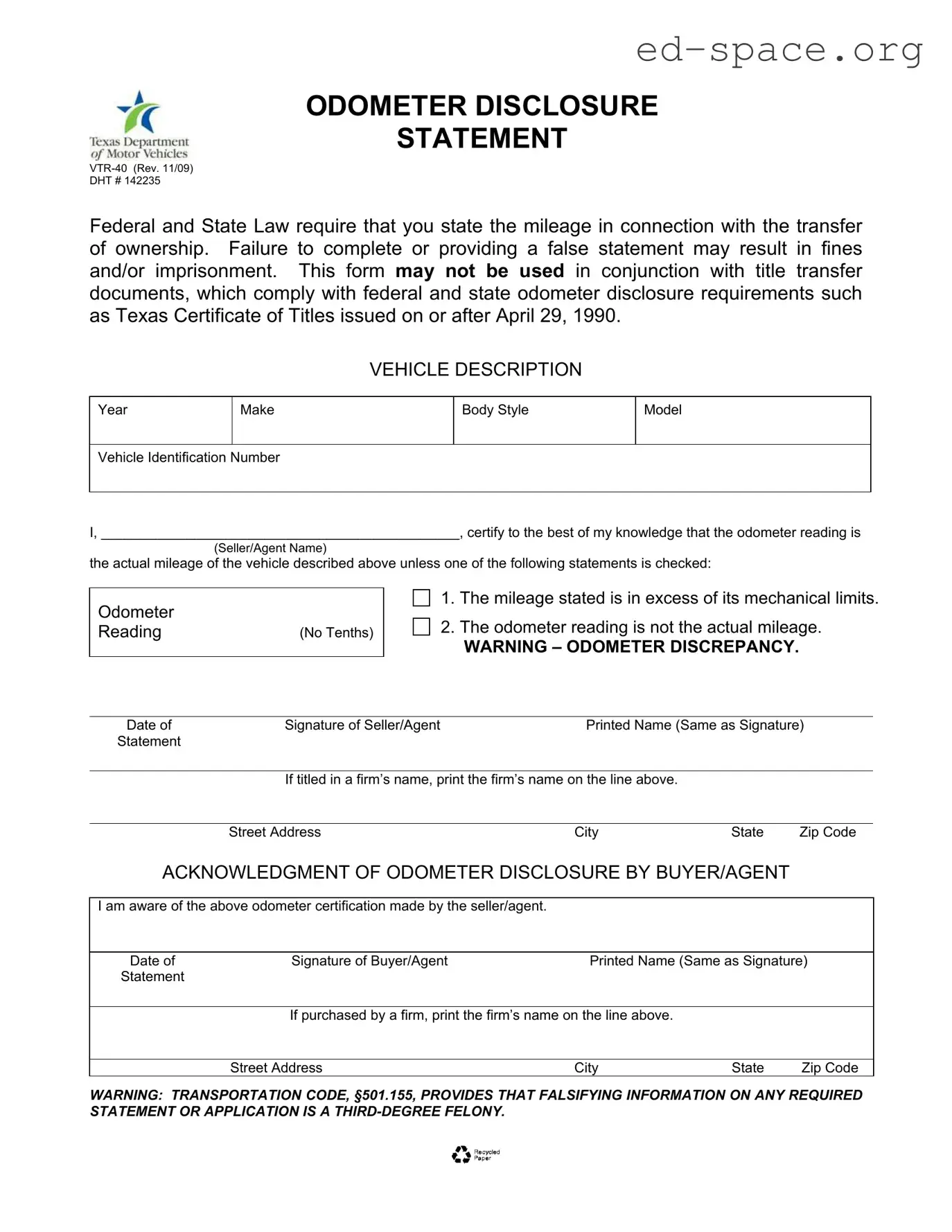What is the Texas Odometer Statement form (VTR-40) used for?
The Texas Odometer Statement form, also known as VTR-40, is a crucial document used during the sale or transfer of a vehicle. It requires the seller to disclose the accurate mileage of the vehicle at the time of sale. This ensures transparency and honesty in the transaction, as federal and state laws mandate that the mileage be stated in connection with the transfer of ownership. Omitting this information or providing false statements can lead to severe penalties such as fines or imprisonment.
When is using the Texas Odometer Statement form not applicable?
This form is not applicable for title transfer documents that already comply with federal and state odometer disclosure requirements. For instance, Texas Certificate of Titles issued on or after April 29, 1990, have built-in sections for odometer disclosure, making the VTR-40 form unnecessary in such cases.
What are the penalties for failing to complete the Texas Odometer Statement form or providing false information?
Failing to complete the Texas Odometer Statement form or providing false information can result in significant penalties, including fines and/or imprisonment. This strict stance underscores the importance of accurate and honest disclosures regarding a vehicle's mileage during ownership transfers.
How do I fill out the odometer section if the vehicle's mileage exceeds its mechanical limits?
If a vehicle's mileage exceeds its mechanical limits, you should check the corresponding box on the form indicating that the mileage stated is in excess of its mechanical limits. This is important for older vehicles that have odometers capable of displaying a maximum of 99,999 miles, which might roll over after hitting this limit.
What should I do if the odometer reading is not the actual mileage of the vehicle?
If the odometer reading is not the actual mileage of the vehicle, mark the provided option stating, "The odometer reading is not the actual mileage. WARNING – ODOMETER DISCREPANCY." This is crucial for instances where the odometer may have been tampered with or is malfunctioning, ensuring the buyer is made aware of potential discrepancies.
Who needs to sign the Texas Odometer Statement form?
Both the seller or the seller's agent and the buyer or the buyer's agent must sign the Texas Odometer Statement form. This acknowledgement from both parties ensures that the seller has provided the odometer disclosure and that the buyer is aware of the odometer reading and any disclosed discrepancies at the time of purchase.
Is this form required for all vehicle sales in Texas?
Yes, the Texas Odometer Statement form is required for all vehicle sales in Texas when the title transfer documents do not comply with federal and state odometer disclosure requirements. Its aim is to protect buyers and sellers by ensuring mileage accuracy and providing a clear record of the vehicle's history.
Can I use the Texas Odometer Statement form for vehicles titled out of state?
While the Texas Odometer Statement form is designed to comply with Texas state requirements, its applicability to vehicles titled out of state may vary based on the specific requirements of those states. It's advisable to consult with the relevant state's motor vehicle department or a legal expert to ensure compliance.
What happens if a discrepancy is found after the sale regarding the odometer reading?
If a discrepancy regarding the odometer reading is discovered after the sale, it could lead to legal disputes or actions. The buyer may have grounds to claim against the seller if it can be proven that the odometer was tampered with or if false information was knowingly provided. This situation underscores the importance of accurate disclosure on the Texas Odometer Statement form.
Where can I find the Texas Odometer Statement form?
The Texas Odometer Statement form, or VTR-40, can be obtained from the Texas Department of Motor Vehicles (TxDMV) website or at local TxDMV offices. It is vital to use the latest version of the form to ensure compliance with current laws and regulations regarding odometer disclosure during vehicle transactions.

